Fort Mott, located in Pittsford, Vermont, was a picket fort used by American militiamen during the American Revolutionary War. The fort was constructed by the citizens of Pittsford as a sanctuary in case of approaching British troops or hostile Native Americans. The Battle of Hubbardton was the only major battle fought in Vermont during the war. Just before the battle, fought on July 7, 1777, the townspeople of Pittsford had to evacuate the town. Those that returned decided to build the fort for their own protection; construction was finished later that same year. It is located on the east bank of the Otter Creek, which provided the fort's fresh water. It was only later named Fort Mott, after, the fort's commander, John Mott.
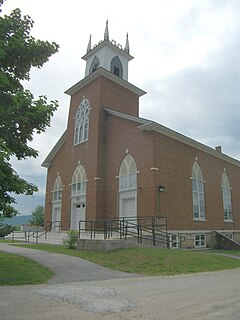
Pittsford is a town in Rutland County, Vermont, United States. As of the 2010 census, the town population was 2,991. Named for William Pitt, it has two picket forts used in the American Revolutionary War.

Vermont is a state in the New England region of the northeastern United States. It borders the U.S. states of Massachusetts to the south, New Hampshire to the east, New York to the west, and the Canadian province of Quebec to the north. Vermont is the second-smallest by population and the sixth-smallest by area of the 50 U.S. states. The state capital is Montpelier, the least populous state capital in the United States. The most populous city, Burlington, is the least populous city to be the most populous city in a state. As of 2015, Vermont was the leading producer of maple syrup in the United States. In crime statistics, it was ranked as the safest state in the country in 2016.

A militia is generally an army or some other fighting organization of non-professional soldiers, citizens of a nation, or subjects of a state, who can be called upon for military service during a time of need, as opposed to a professional force of regular, full-time military personnel, or historically, members of a warrior nobility class. Generally unable to hold ground against regular forces, it is common for militias to be used for aiding regular troops by skirmishing, holding fortifications, or irregular warfare, instead of being used in offensive campaigns by themselves. Militia are often limited by local civilian laws to serve only in their home region, and to serve only for a limited time; this further reduces their use in long military campaigns.

Lake Champlain is a natural freshwater lake in North America mainly within the borders of the United States but partially situated across the Canada–U.S. border, in the Canadian province of Quebec.

The Green Mountain Boys was a militia organization first established in the late 1760s in the territory between the British provinces of New York and New Hampshire, known as the New Hampshire Grants and later in 1775 as the Vermont Republic. Headed by Ethan Allen and members of his extended family, it was instrumental in resisting New York's attempts to control the territory, over which it had won de jure control in a territorial dispute with New Hampshire.

Pittsford is a village in Monroe County, New York, United States. The population was 1,355 at the 2010 census. It is named after Pittsford, Vermont, the native town of a founding father.
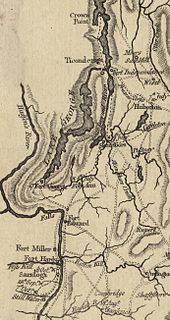
The Battle of Hubbardton was an engagement in the Saratoga campaign of the American Revolutionary War fought in the village of Hubbardton, Vermont. Vermont was then a disputed territory sometimes called the New Hampshire Grants, claimed by New York, New Hampshire, and the newly organized and not yet recognized but de facto independent government of Vermont. On the morning of July 7, 1777, British forces, under General Simon Fraser, caught up with the American rear guard of the forces retreating after the withdrawal from Fort Ticonderoga. It was the only battle in Vermont during the revolution.
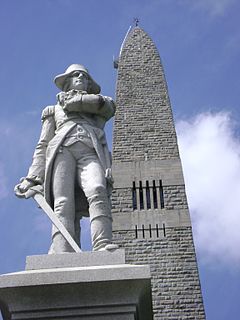
Seth Warner was a Revolutionary War officer from Vermont who rose to rank of Continental colonel and was often given the duties of a brigade commander. He is best known for his leadership in the capture of Fort Crown Point, the Battle of Longueuil, the siege of Quebec, the retreat from Canada, and the battles of Hubbardton and Bennington.
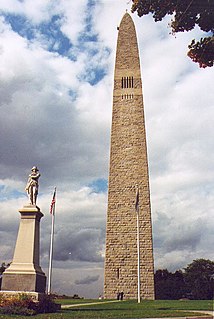
The Bennington Battle Monument is a 301-or-306-foot-high stone obelisk located at 15 Monument Circle, in Bennington, Vermont, United States. The monument commemorates the Battle of Bennington during the American Revolutionary War.

George Jerrison Stannard was a Vermont farmer, teacher, governmental official and Union general in the American Civil War.
Carleton's Raid was a British raid led by Major Christopher Carleton during the American War of Independence, conducted in fall 1778 from the Province of Quebec against targets in upstate New York and the Vermont Republic.

Otter Creek is one of the major streams located in the state of Vermont. Roughly 112 miles (180 km) in length, it is the primary stream running through Rutland County and Addison County. It is one of the largest rivers in the state.
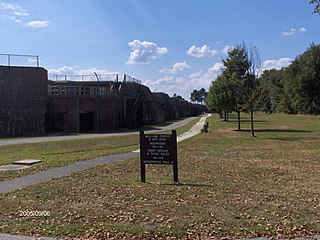
Fort Mott, located in Pennsville, Salem County, New Jersey, was part of the Harbor Defenses of the Delaware, a three-fort defense system designed for the Delaware River during the postbellum and Endicott program modernization periods following the American Civil War and in the 1890s. The other two forts in the system were Fort Delaware on Pea Patch Island and Fort DuPont in Delaware City, Delaware.
The Vermont Railway is a shortline railroad in Vermont and eastern New York, operating much of the former Rutland Railway. It is the main part of the Vermont Rail System, which also owns the Green Mountain Railroad, the Rutland's branch to Bellows Falls. The trackage is owned by the Vermont Agency of Transportation except in New York, where VTR operates a line owned by the Boston and Maine Corporation. The rail line employs about 150 people in Vermont.
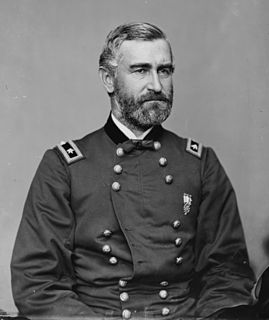
Gershom Mott was a United States Army officer and a General in the Union Army, a commander in the Eastern Theater of the American Civil War.

Colonel Caleb Hopkins was a War of 1812 hero and the first town supervisor of Pittsford, New York, USA.

The Crown Point Road, or the Crown Point Military Road, is a historic road built in 1759-60, mostly in what is now the United States state of Vermont. It was built by British Army and colonial militia forces to connect Fort Crown Point near the southern end of Lake Champlain to the Fort at Number 4 in what is now Charlestown, New Hampshire. It was the first major road in Vermont, spurring development along its route after the French and Indian War. Fragments of the road are still visible in largely period condition, or have been paved over, while others have disappeared into the forest. Sections of the road located in Weathersfield have been listed on the National Register of Historic Places.
Mott is a surname and given name.
The military history of Vermont covers the military history of the American state of Vermont, as part of French colonial America; as part of Massachusetts, New Hampshire and New York during the British colonial period and during the French and Indian Wars; as the independent New Connecticut and later Vermont during the American Revolution; and as a state during the War of 1812 and the American Civil War.
Brevet Lieutenant Colonel Martin Scott was a career officer in the United States Army who was a signatory to the Treaty of St. Peters in 1837.

The Fort Vengeance Monument Site is an archaeological and commemorative site on United States Route 7 in northern Pittsford, Vermont. The site includes the archaeological remains of one of Vermont's oldest documented homesteads, and the only surviving site of a state-ordered military fortification of the American Revolutionary War. The site is marked by a stone memorial placed in 1873, and was listed on the National Register of Historic Places in 2006.














